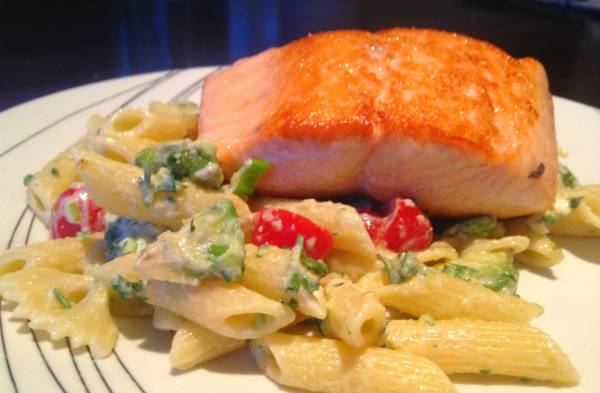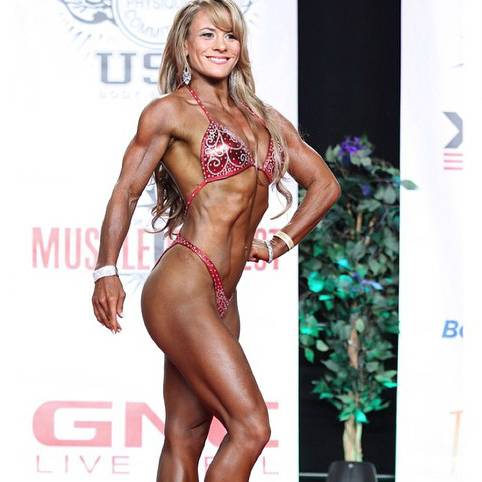According to the World Health Organization, the worldwide obesity rate has more than doubled since 1980. In 2014, 39 percent of adults over the age of eighteen were overweight, and 13 percent were obese.1 This is a scary statistic – almost half the world’s population are overweight.
It’s no wonder so many people always seem to be on a diet of some sort. However, diets are part of the problem. Understanding the right way to eat is the key to avoid diets and all the negative aspects that go along with them. For athletes, understanding the powerful effects food has on the body can help you reach your sport-specific goals without dangerously cutting calories.
I’m going to talk you through my extensive experience as a gymnast, BJJ competitor, and figure competitor. As you can imagine, my eating plan varies according to my current competitive goal. But at no point does it involve suddenly cutting a lot of weight or drastically dropping calories. Let’s start with some of the basic facts of calorie-restricted diets.
Understanding the powerful effects food has on the body is critical.
The Dangers of Calorie Controlled Diets
Dieting or calorie restriction is detrimental to your health for many reasons.
Nutrient Deficiency: Dieting deprives your body of vital macronutrients such as proteins and their essential amino acids, as well as fats, essential fatty acids, and carbohydrates. Calorie restriction often leads to a lack of vitamins, minerals, phytonutrients, and enzymes essential for all your basic biological functions. This deficiency causes low energy levels and lethargy, a decreased ability to heal from cuts and bruises, and a compromised immune system.
Slower Metabolism: Your metabolic rate, the rate at which your body utilises your fuel for energy will slow down over time to compensate for the lack of fuel it is receiving and you will burn calories less efficiently. Additionally, not eating enough puts your body in a state of stress. Since your body thinks it is in a famine, the stress causes your body to store the calories you consume.
Catabolism: Long-term yo-yo dieting and calorie restriction puts your body into a catabolic state, which leads to a decrease in muscle mass, loss of strength, and diminished performance. A starving body prefers to break down muscle tissue for energy rather than using its fat stores, since muscle requires more energy maintenance. Each muscle cell is a little powerhouse that turns your food into energy and burns fat. Cutting into your muscle mass will slow down your metabolism and lead to more weight gain over time.
Modify Your Eating Plan for Your Sport
I have practiced a number of disciplines that require me to be a certain weight, look a certain way, or both. Through trial and error and consultation with my coaches and other professionals, I figured out the best way to modify my eating plan and achieve my desired outcome for each sport:
Gymnastics: Gymnastics requires that I am strong with low body fat. I need the energy to endure 4 ½ hour training sessions, and explosive power to do all the plyometric floor tumbles and vault jumps.
Brazilian Jiu Jitsu: As a Brazilian jiu jitsu practitioner, I require muscular endurance since my training sessions are long and the fights at black belt level last for ten minutes. I also need explosive power to be able to execute some of the techniques such as take downs and finishing sweeps. Additionally, I need to make weight for my category at tournaments.
Bodybuilding: Ms. Figure shows require that I sit at around 5-8 percent body fat, which is extremely low for a woman.
Click page 2 below to learn how I eat when training for BJJ and gymnastics.
Fuelling for BJJ and Gymnastics
My eating plans for gymnastics and BJJ are similar because the training sessions are long and the techniques require endurance and power. While training for BJJ or gymnastics, I eat 4-5 times per day, about every 3 ½ hours. For these sports, I focus on the meal immediately before and right after the training session.
Pre-Workout
If I do not feed my body properly before my workouts, I won’t have the energy or power I need. I eat 1 ½ hours before class time to ensure that I digest my meal properly. My meal always consists of a combination of carbohydrates, proteins, and fats.
I usually pair complex carbohydrates, such as ½ or 1 cup of brown rice or sweet potato, with a protein source, such as a palm-size piece of fish, or 3 – 4 eggs with the yolks. The fats in the yolks provide energy and also slow down the rate of absorption of the complex carbohydrates. This results in a slower and longer lasting release of energy.
Post-Workout
I always try to eat something immediately after training. My blood sugar levels are low and my body craves carbohydrates to refuel my glycogen stores. I usually eat a banana with peanut butter and a cup of cereal – usually granola, since it doesn’t contain wheat.
If there ever is a time to each higher glycaemic carbs or a carbohydrate dense meal that will give you an insulin spike, it is right after a hard training session. Your body will shuttle the glucose from the carbohydrates into your muscles as glycogen before storing them as fat. So even though this meal is carbohydrate-heavy, I manage to keep my body fat low (usually around 10 percent) because I only eat this meal right after a training session. The small amount of protein in the peanut butter also helps replenish and repair my muscles after intense training.
About an hour later I eat another meal consisting of complex carbohydrates, proteins, and fats. This usually consists of ½ or 1 cup of brown rice, pasta, or sweet potato, a palm-sized piece of chicken or salmon, and an entire plate full of salad with olive oil and avocado.

Post-workout meal containing complex carbs, protein, and fats.
Importance of Fats
Fats reduce the need to fill up on processed carbohydrates, and they also kept my joints feeling supple. I never experience joint pain like my other team mates. After thirteen years of BJJ and still going strong, I don’t feel pain in the joints of my fingers, despite the fact that I have broken each one.
But it is important to eat the right type of fats. Monounsaturated fats, such as olive oil, and unrefined polyunsaturated fats from salmon reduce inflammation. Every day I eat a piece of salmon which is high in omega-3 fatty acids, as well as eggs, nuts or nut butters, avocado, and oils such as coconut and olive oils. On a typical day I consume around 150g of fat.
Competition
I allow about six weeks to lose weight safely when I need to cut weight for a tournament. I never do water cuts, since weigh-ins are right before the fight and not the day before like wresting and MMA. I do not skip meals or drastically cut my calories. Instead, I increase my water intake from 3 litres to around 5 litres. I only eat high-carbohydrate meals directly after a training session, and I eat small, frequent meals.
Click Page 3 to learn how I adapted this eating plan for Ms. Figure competitions.
Preparing for Ms. Figure
Preparing for a Ms. Figure show has a completely different objective. It is all about how you look for a small period of time, rather than how you perform. However, the preparation involved is painstakingly long.
Most bodybuilding competitors begin their preparation 8-16 weeks out from their show, depending on their level of body fat. Since I always stay lean, I start 8 weeks out. Instead of eating 4-5 times per day, I switch to 5-6 meals per day and reduce the size of each meal. Keeping your body constantly supplied with small meals keeps your metabolism elevated. Since the meals are small, the body utilises everything for energy and there is nothing left over to store.

Since the meals are small, the body utilises everything for energy and there is nothing left over to store.
Protein
Protein is the main staple in this eating plan. Every meal consists of about 30-40g of protein. I eat close to 200g of protein per day since my carbohydrates and fats are lower and I need to keep my caloric intake up. I also consume higher levels of protein to maintain muscle mass while my body is not getting as much carbohydrate and fats for energy.
The majority of my protein comes from egg whites, fish, and a high-quality whey protein isolate (protein shake). I drink at least 4 litres (1 gallon) of water per day. This keeps my kidneys and liver functioning optimally and helps them process the proteins.
Fats
The meals I eat while preparing for a Ms. Figure show are all low in fat. I want to encourage my body to use its fat stores rather than the fat supplied through diet. I cook with coconut oil and add olive oil to my salads, but I cut out nut butters, and add only one whole egg to four or five egg whites.
Carbohydrates
All my meals contain carbohydrates derived from vegetables and salads. I limit dense, grain-based complex carbohydrates to two meals per day. I eat ½ cup of rice or sweet potato in a meal right before and right after a workout. I also don’t eat very much fruit, since the simple sugars are broken down too easily and could result in an insulin spike. Reducing carbohydrates also lowers my subcutaneous water, which is important when you need your skin to be as thin as possible to show maximum muscular definition.
Timings
The timing of each meal is imperative. I never skip a meal. I eat every two and a half to three hours religiously. If my body thinks it is not getting calories for even a short amount of time, it will release cortisol and more lipolytic (fat storing) enzymes. It will also be more likely to store any calories when supplied and cut into my muscle for energy.
“Long-term calorie restriction, cutting calories, and skipping meals is not the answer.”
Since I am expending less calories during Ms. Figure prep, I reduce my calories accordingly. However, I do not reduce my calories below my basal metabolic rate, nor do I deprive my body of calories it needs to function optimally and get through my workouts.
The Fundamentals Are the Same
Whether I am training for a BJJ competition, prepping for a Ms. Figure show, or just trying to maintain a healthy weight, the fundamentals are the same: a healthy eating plan consisting of the right types of foods such as whole grains, fruits, lean meats, eggs, good fats, and an abundance of fresh vegetables. Eating regular, smaller meals is also important, as is drinking a lot of water throughout the day.
If you are a serious athlete, tweak your eating plan to suit your specific goals. Small, consistent changes over time can increase your performance and help you to achieve your weight and body fat goals. Long-term calorie restriction, cutting calories, and skipping meals is not the answer. Tailor your diet to your needs to achieve the outcomes you desire.
You’ll also enjoy:
- How to Avoid the Fad Diet Cycle (and Keep the Weight Off)
- How Restricting Calories and Nutrients Affects Your Health
- Eat to Perform: Simple Dietary Advice for the Athlete
- New on Breaking Muscle AU
References:
1. World Health Organization: Obesity and overweight Fact sheet N°311 January 2015






